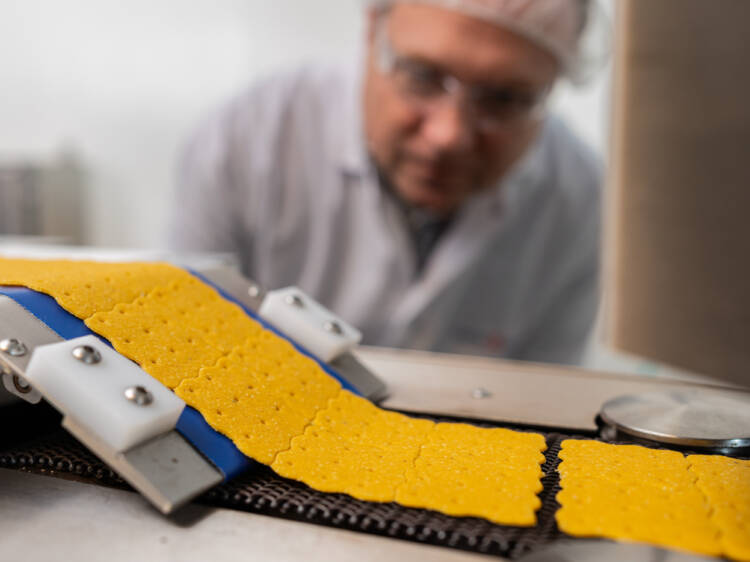Nailing Your Next Snack Texture
By Michael Merkely, Senior Scientist
Texture is a crucial factor in consumer satisfaction and product differentiation. In fact, I’d wager that you could tell your favorite baked snack from similar products in a blind test by the texture alone; that familiar mouthfeel is part of what makes it an enjoyable experience.
For a new snack to win you over, it must provide an exciting sensory experience or replicate a familiar one. Again, texture plays a significant role in this. The crispy or crunchy texture of a snack can greatly influence its appeal, making it essential for us to prioritize texture in our formulations.[1]
At Tate & Lyle, we leverage texture maps and sensory lexicons to ensure each snack offers the perfect mouthfeel. By understanding how different textures are perceived, we can craft snacks that provide the satisfying crunch or crispiness that consumers crave.
The Science Behind Texture and Mouthfeel
The science of texture and mouthfeel is integral to our product development process. Consumers have specific expectations for sheeted snacks, like crackers and chips, that must be met, regardless of your ingredient or nutritional goals. More than with most other foods, they’re looking for just the right mouthfeel, be that crispiness or crunchiness, in addition to great taste.
So, how do you create the ideal texture in a snack? In the simplest terms, it’s all about water management. You have to add enough water for processing to form the dough sheet. But these are low-moisture products, so you then bake all that moisture out. Balancing the ingredients and how they absorb water and then release it in the oven greatly influences the texture.
Tools we have at our disposal, like texture maps and sensory lexicons, enable us to reverse engineer the desired texture, starting from consumer preferences and working back to the ingredient functionalities.
By understanding the functional properties of different starches and flours, we can design snacks with precise textures. This scientific approach ensures that each product meets sensory expectations while maintaining the necessary functionality throughout processing.
Integrating Product and Process
In snack production, it’s essential to understand that the product formulation and manufacturing process are inseparable. The process used to make the product is part of what creates the texture and the product characteristics in general.
Traditional wheat flour is well understood for its unique viscoelastic properties, making it predictable and forgiving in formulations. However, when replacing wheat with alternative ingredients like chickpea flour, everything changes. That’s true whether you’re removing wheat flour for a gluten-free product or pairing it with another flour for a fiber claim or other nutritional benefit.
Chickpea flour, for example, holds water between its particles rather than absorbing it like wheat. This difference in water management can lead to distinct textures, such as harder or crunchier results, and creates new challenges in the baking process. In the past, we primarily used starches to change the texture of a formulation. But now, we know flour, like chickpea flour, can be a texturant in its own right. So, we use flour as an additional tool to change some of those textures as well.
Of course, whenever you add to a product formulation, it's more complicated than just plugging in an ingredient. You have to factor in how that ingredient will likely change the process and the bake profile. You have to be cognizant of how it affects the dough rheology and then, in turn, how that affects your dough sheets. That includes dough extensibility, how it runs through the equipment, how it cuts and how it bakes.
Addressing Consumer Demands
Consumers, naturally, know nothing of the complexity of sheeted snack formulation. But they do know what they want! For example, they are demanding healthier snacks; 67% of US cracker consumers want to see options with more health benefits.1 The typical consumer, however, will only compromise on texture and flavor so much—and it isn’t much. Perhaps that’s because, in the past, better-for-you snacks frequently missed on taste or texture? We do know that 64% of consumers pay more attention to the sensory attributes of their snacks now than they did five years ago.2
And why shouldn’t they? A good snacking occasion adds something positive to your day. They can be fun, satisfying, convenient, rewarding, and indulgent. Meeting all their demands comes with challenges for the formulator.
For example, if you think of low-fat products, the fat provides texture and flavor. You can reduce it, of course, but if you're not building some of that mouthfeel and taste back into the product, it won’t gain wide acceptance. In the end, the most successful products incorporate the best solutions for the technical challenges and compromise the least.
At Tate & Lyle, we've taken the approach with our applications team, of which I'm a part, that it doesn't matter what they're asking for. Our job is to be ready for our customers’ challenges and create foundations that better anticipate any potential outcomes. With that knowledge base, our technical service and sales teams can fine-tune and pivot to different solutions based on their exact customer situation.
Understanding the Tate & Lyle Approach
Part of my role is creating the ingredient foundations that can be tweaked and modified and made into a final product. The concept of a solutions platform is fundamental to our approach at Tate & Lyle.
Think of it like building a car: the frame, wheels, and tires provide a starting point that can be adapted into various vehicle types—convertible, sedan, or coupe—depending on what is needed. Similarly, we use our ingredients to form a versatile base for creating different snack products. This allows us to maintain a reliable foundation—or model system—while customizing textures to suit specific consumer preferences and product requirements.
These model systems are simplified formulas for ease, repeatability, and reduced variability. As we add ingredients to build our custom formulations, we know the base well enough to recognize what changes in baking performance the new additions have introduced. For example, we once experimented with including potato and pre-cooked rice flour for water absorption. But, we found when we then added chickpea flour, we couldn’t differentiate what impact the chickpeas had on the formula from what the rice and potato added. Ultimately, we went with a simpler formulation to make fine-tuning much simpler.
Having a robust platform from which to start development means we can efficiently create a variety of snack textures, ensuring that each product not only meets high-quality standards but also appeals to diverse market needs.
Practical Applications and Success Stories
Our proven system helps us help food and beverage companies innovate their product lines.[2] For instance, as of the time of writing, I’ve been working with a customer whose existing product has been on shelves for over 100 years. It's an iconic snack, and they want to make a gluten-free version of it. But they want it to have the texture, flavor, and characteristics of that original product.
At first, the textures we created did not match up to that original product. We performed a designed experiment, a systematic approach, to screen through what were the main drivers of this texture. By systematically experimenting and optimizing ingredients, we were able to closely replicate the original texture and flavor, demonstrating our ability to deliver tailored solutions.
Innovative Ingredients and Their Benefits
We are fortunate at Tate & Lyle to have a remarkable toolkit of ingredients to work with in addition to our skilled and passionate team.
Take our ARTESA® Chickpea flours. Chickpea flour is particularly valuable in gluten-free formulations. It holds water in a way that leads to crunchier textures, making it an ideal ingredient for creating satisfying snacks. Not only that, but it’s also what we’d consider a “clean label” flour, so it can help simplify your ingredients list, something many consumers are looking for in their snacks.
Another go-to solution for texture is our X-PAND’R® starch range. We like to think of it as our “snack starch.” In a gluten-free system it can replace that developed gluten network you’re losing and replicate some of those properties the gluten has, notably the dough cohesiveness and extensibility. Even in a wheat cracker, it can enhance those characteristics. It's also great at expansion; you might use it to create bubbles in the dough matrix, and then when you bake or fry the product, they expand and form that kind of bubbly textures you find in a lot of snack crackers on the market now.
In fact, we’ve recently created a snack prototype made primarily of chickpeas using our ARTESA® 20 and ARTESA® 10 flours and X-PAND-R® 612 starch. Beyond just being a gluten-free snack, it's a testament to what you can achieve with very simple ingredients. These are not merely nutritional additives; they are functional components that enhance the texture and quality of snacks.
Partnering with Tate & Lyle
As I look ahead to the future of snacking, I see more focus on nutritional snacks and ones that appeal to a specialty diet, like low-net carb or keto products. In preparation, we're always working on ways to improve those textures and make them better representations of what they were meant to mimic. If you think of generational products, we're probably 15 years from the first to the latest iteration of low-carb options. Compared to those first-generation products, what we have today is much better, and they're improving all the time. There's been more focus and energy put towards those healthier categories— it’s absolutely a growth area—and we want to be part of it.
That’s why, at Tate & Lyle, we offer more than just ingredients; we provide comprehensive solutions. Our approach involves anticipating customer challenges and delivering tailored solutions that integrate ingredient functionality with processing techniques. With our deep understanding of texture creation and a robust portfolio of mouthfeel ingredients, we can help you develop snacks that delight consumers and stand out in the market. Partner with us, and we’ll create the right snacks for the right moment.
- Mintel, The Future of Biscuits, Cookies and Crackers 2024
- Mondelez, State of Snacking 2023

